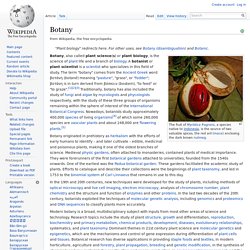

Botany. Botany, also called plant science(s) or plant biology, is the science of plant life and a branch of biology.

A botanist or plant scientist is a scientist who specializes in this field of study. The term "botany" comes from the Ancient Greek word βοτάνη (botanē) meaning "pasture", "grass", or "fodder"; βοτάνη is in turn derived from βόσκειν (boskein), "to feed" or "to graze".
Flowers. Trees. Plant pathology. Pathogen life cycle Plant pathology (also phytopathology) is the scientific study of plant diseases caused by pathogens (infectious organisms) and environmental conditions (physiological factors).[1] Organisms that cause infectious disease include fungi, oomycetes, bacteria, viruses, viroids, virus-like organisms, phytoplasmas, protozoa, nematodes and parasitic plants.

Foraminifera. The Foraminifera ("hole bearers", or forams for short) are a phylum or class of amoeboid protists.

They are characterized both by their thin pseudopodia that form an external net for catching food, and they usually have an external shell, or test, made of various materials and constructed in diverse forms. Most forams are aquatic, primarily marine, and the majority of species live on or within the seafloor sediment (benthos) with a small number of species known to be floaters in the water column at various depths (plankton). A few are known from freshwater or brackish conditions and some soil species have been identified through molecular analysis of small subunit ribosomal DNA.[1][2] Classification-taxonomy[edit] The taxonomic position of Foraminifera has varied since their recognition as protozoa (protists) by Schultze in 1854,[5] there referred to as an order, Foraminiferida. Living foraminifera[edit] Biology[edit] GMO FOODS. Plant Communication. Plant Communication. Green World "For in the true nature of things, if we rightly consider, every green tree is far more glorious than if it were made of gold and silver.

" ~ Martin Luther Photo Credit: GoodFon.ru. Why Do Some Clovers Have Four Leaves? The leaves of clover plants are said to hold the luck o' the Irish when they sport four leaves.

This myth likely arose because four-leaf clovers are rare finds — the result of an equally rare genetic mutation in the clover plant. There are about 300 species in the clover genus Trifolium, or trefoil, so named because the plants usually have three leaves, or technically, leaflets. The ones you typically find in North America are white clover (Trifolium repens). Typically all clover plants feature leaves that have three leaflets on them — legend has it that St. Patrick used this so-called shamrock as the symbol of the Holy Trinity. "The 4-leaf (technically, 4-leaflet) and higher-leaflet variants are caused by rare genetic mutations," biologist Kenneth Olsen of Washington University in St. The Saguaro Cactus and its visitors.
In May, Saguaro Cacti form crowns of flower buds on the ends of arms and the main stem.

The crown is actually a spiral of more mature buds on the outside, and smaller ones closer to the apical growth spot. The flowers open up a few at a time, so the bloom can go on for several weeks. Any individual flower opens during the night and rarely lasts longer than until noon of the next day. By then the waxy flower starts to wilt. It has almost certainly been visited by several pollinators since Saguaro flowers attract scores of very different animals with great amounts of pollen and nectar, Famously, Lesser long-nosed bats, migrating through our area just when the Saguaros bloom, are considered a main Saguaro pollinator.
White-winged Doves seem to time their return from southern wintering grounds and their breeding to enjoy both the nectar and soon after the juicy fruits of our Saguaros. Noisy, raucous Cactus Wren families drop in from their nest in a nearby Cholla.